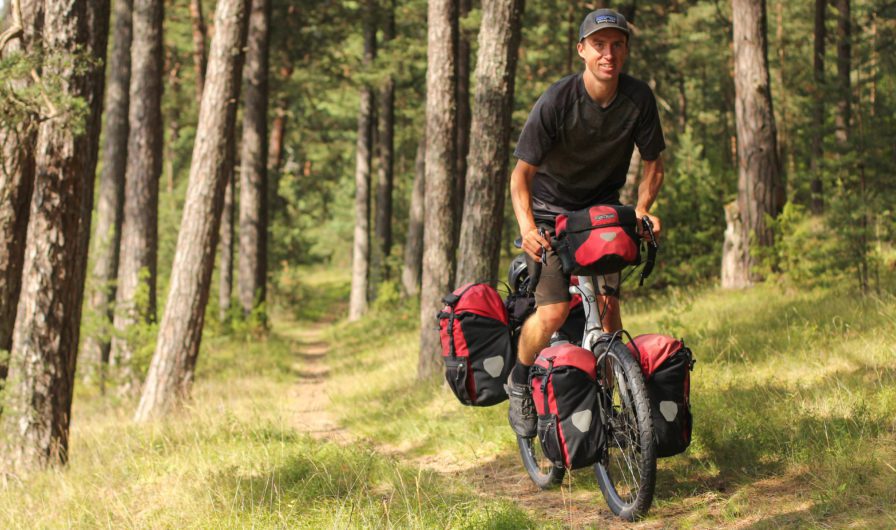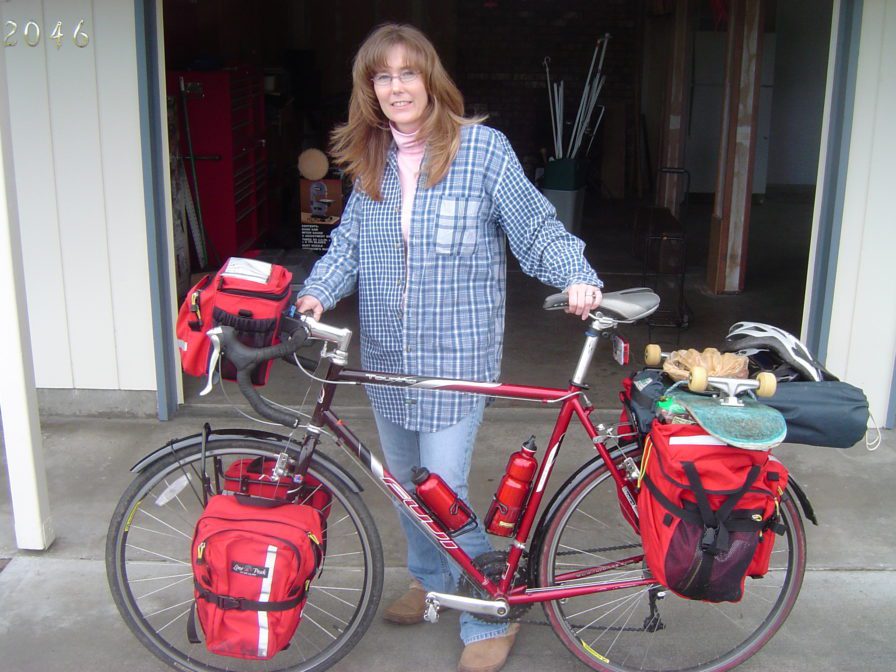How Much Should Your Touring Bicycle Weigh?

Podcast: Play in new window | Download
Subscribe: RSS
How much should your touring bicycle weigh? Well, it’s hard to say exactly.
The vast majority of touring bicycles weigh 26 – 33 lbs (12 – 15 kg) when they are equipped with only fenders, front and rear racks, and water bottle cages. It’s important to note, however, that touring bicycles come in all kinds of different shapes and sizes, so the weight of these bicycles can vary quite a bit depending on the model, size, and brand of accessories that are used in conjunction with the bike.
In addition to all that, it’s important to understand that there are commuter-style bicycles built for local riding; lightweight touring bicycles built for sport touring and going really fast; touring bicycles built for short weekend-style getaways; touring bikes made to take you and your gear long distances on paved surfaces; and touring bikes that will comfortably transport you down bumpy gravel roads or narrow single-track trails.
As you can imagine, there are some pretty big variations in weight among these different types of touring bikes!
How Much Does Your Touring Bicycle Weigh?

As the Bicycle Touring Pro, it’s extremely common for my readers to write to me and ask, “How much does your touring bicycle weigh?” Weight after all, is a pretty obvious concern for people who aren’t used to cycling with all of their personal belongings strapped to the frame of their bicycle. And when you see a fully-loaded bicycle tourist cycling down the road, it’s easy to wonder, “How much does that bicycle weigh?”
That’s why I recently took some time to weigh three of my own touring bicycles… and I’d like to share the results of those measurements with you now.
For this article, I decided to weigh my Fuji Touring bicycle, my Co-Motion Pangea, and my Co-Motion Siskiyou touring bicycle (which is equipped with an 18-speed Pinion gearbox and a Gates carbon drive system instead of a traditional metal chain and derailleur setup like you see on most bicycles).
Please note that each touring bicycle listed here was weighed with front and rear fenders, front and rear racks, and a set of water bottle cages. The weight does not include water bottles, water, food, panniers, frame packs, seat packs, handlebar bags or any additional accessories.
What you’ll see by looking at the weight of these three touring bikes is that the differences in weight are quite significant!
Fuji Touring

- Total weight: 31.8 lbs (14.42 kg)
The Fuji Touring bicycle is by far the lightest of my three touring bikes. This is no surprise! The Fuji Touring is a lightweight, commuter-style road touring bicycle designed to go fast and carry relatively light loads. The steel frame is so thin (and so light), you can sometimes see the top tube bend back and forth as you pedal down the road.
Co-Motion Cycles Pangea

- Total weight: 33.2 lbs (15.06 kg)
Unlike the Fuji Touring, which is a bike designed for road-based bike tours, the Co-Motion Pangea is a heavy-duty touring bike designed to be ridden on both paved roads and in rocky off-road environments. My particular Co-Motion Pangea is also equipped with a set of S&S couplers, which allows me to split the bicycle in half and carry it with me on an airplane as regular checked baggage. These S&S couplers are great, but they do add some additional weight to the overall bike.
Co-Motion Cycles Siskiyou

- Total weight: 37.2 lbs (16.87 kg)
Finally, the Co-Motion Siskiyou is unsurprisingly the heaviest of my three touring bikes because of the Pinion gearbox that is built into the bicycle’s bottom bracket. This internal gearing system is incredibly nice to have (because it’s practically maintenance-free and is super easy to use), but it does have one obvious drawback – it’s heavy!
Considering the Co-Motion Pangea and the Co-Motion Siskiyou are practically the same bicycle (the only major difference being the size of the wheels/tires and the Pinion gearbox and Gates carbon drive on the Siskiyou), it’s easy to see just how much weight that Pinion gearbox ultimately adds to the overall weight of the bike – approximately 4 total lbs! (1.8 kg).
How Much Does A Loaded Touring Bicycle Weigh?

A loaded touring bicycle is far heavier than a bike fitted only with racks, fenders, and water bottle cages. Once you add camping equipment, food, clothing, water, toiletries, and other personal items, your loaded touring bicycle might weigh 30 – 60 lbs (13 – 27 kg) more than it did previously. This means that a fully-loaded touring bicycle can weigh as much as 60 to 100 lbs (27 – 45 kg).
In some instances, you will see people traveling on loaded touring bicycles that weight 100 lbs (45 kg) or more! This is usually because the individual has packed too much; is carrying large, heavy gear; is cycling in the winter (which requires more, bigger, heavier clothing); or because the individual is doing something unique (such as traveling with a dog, pack-raft, computer, drone, skateboard or other such personal items).
Keep in mind that the weight of your bicycle is going to vary from day to day. Food and water can weigh a lot. If you’re picking up new food and water on a daily basis, then your bicycle is going to be fairly light in comparison to someone who might need to pack several days worth of food and water on his or her bike in order to reach the next supply point.
Ultimately, there is no rule as to how much your loaded touring bicycle should weigh. However, some effort should be made to make your bicycle weigh as little as possible. The lighter your bike, the easier it will be to ride and the further your will be able to cycle on any given day.
In other words: Lighter = faster and easier.
How To Find Your Ideal Touring Bike Weight

Now that I’ve given you some general information about the overall weight of loaded and unloaded touring bicycles, it’s important to understand that not all cyclists are equal – and neither should the weight of all touring bikes!
For example, a small woman (weighing only 100 lbs) might not want to carry as much weight on her bicycle as a large man (weighting 250 lbs or more). Sure, both individuals could ride a bike weighing 100 lbs or more, but the man is going to have an easier time pushing that heavy load than the woman, simply because of his size.
In the end, the woman might be comfortable riding a bicycle that weighs closer to 60 lbs, whereas the man might be okay with riding a bike that weighs 80 lbs.
Keeping the weight of your touring bicycle in proportion to your size, fitness, and level of health is important. This is why I recommend your loaded touring bicycle be no heavier than something you can comfortably lift and carry up or down a flight of stairs.
That’s right! If you can’t pick up your bicycle and carry it up or down a flight of stairs, then your bicycle might be too heavy for you.
This is not a die-hard rule that must be followed exactly. Instead, it is simply a suggestion for keeping the weight of your touring bicycle within a comfortable limit based on your body type and overall strength.
In other words, the weight of your touring bicycle should be in proportion to your body and overall level of fitness. Stronger individuals can generally carry more weight than smaller or older individuals. And if you can’t comfortably lift your touring bicycle and walk with it a short distance, carry it up a flight of stairs, or lift it over a fallen log, then it’s very likely that you need to do some work to reduce the overall weight of your bike.
How To Find The Weight Of Your Touring Bicycle

If you have a scale at home, the easiest way to find the weight of your loaded touring bicycle is to first take a measurement of your total body weight. Simply step on the scale and find out how much you weigh. Then write down this number so you will remember it.
Next, grab your loaded touring bicycle and lift it onto the scale with you. This might not be easy to do, so please be careful. You need to stand on the scale while at the same time lifting the loaded touring bicycle completely up off the ground so the entire weight of the bike is being applied to the scale. Now, note the weight of both you and your bicycle and write it down.
Now, simply take the weight of both you and your bicycle and subtract the weight of just your body. The end result will be the weight of your loaded touring bicycle.
For example: Me and my bicycle (245 lbs) – my weight (165 lbs) = 80 lbs (the total weight of my loaded touring bicycle).
How To Reduce The Weight Of Your Touring Bike
Now that you know how much your touring bicycle weighs, the next thing to do is start figuring out how to reduce the overall weight of your bike.

The easiest way to reduce to weight of your loaded touring bicycle is to figure out which items you are not using and then eliminating those items for your gear list. And the easiest way to figure out which items are unnecessary is to conduct several short bike tours near your home. During these short test rides, pay attention to which items you use on a regular basis and which items you rarely, if ever, use.
It’s quite common for individuals to think they are going to use a particular item on their bicycle touring adventures, only to discover once they hit the road that this item is rarely, if ever, put to use. These are the kinds of items you will want to remove from your bicycle in order to reduce the bike’s overall weight.
I recommend conducting several short bike tours near your home as a test. Pay attention to which items you use on a daily basis, and then figure out if you can get rid of the items you aren’t using.
Another easy way to reduce the weight of your bicycle is to purchase smaller and lighter items. Cheap camping and cycling items are usually large and heavy, whereas more expensive pieces of gear and clothing are usually smaller and lighter. If you have the money and/or you’re really concerned about the weight of your bike, then it might be worth shelling out the extra cash to get yourself some small and lightweight gear for your bicycle touring adventures. Tents, sleeping bags, sleeping mats and the clothes you wear are some of the items that generally add the most weight to a loaded touring bicycle, so focus on reducing the size and weight of these items first.
Finally, go through each and every item you are packing with you on your bike tours and cut off or remove any parts of the item that is unnecessary or unused. For example, many pannier bags have buckles, belts and pockets that you might never use. If you aren’t using them, cut them off or remove them!
Removing even a small amount of weight from your gear, clothing and camping equipment can make a significant difference in the overall weight of your loaded touring bicycle and the distances you are ultimately able to cover on your bike tours once you hit the road.
How Much Does Your Touring Bicycle Weigh?

Now it’s your turn to tell me, “How much does your touring bicycle weigh?”
Take a moment right now and weight your touring bicycle – both loaded with gear and unloaded. Then, leave a comment below and tell me which type of bike your are riding and how much your touring bicycle weighs. Over time, it will be interesting to see the huge variation in touring bicycle weights.
If you have further questions on how much your touring bike should weigh, or which items you should or should not pack on a bicycle tour, feel free to leave a comment below. Or see my book, “The Bicycle Touring Blueprint” for more information on what and how to pack for a bike tour of any length.
Podcast: Play in new window | Download
Subscribe: RSS


Hey Darren,
my name is Kathinka, I’m from Germany. My touring bike is a Genesis Croix de Fer from the UK. It weights about 13.5 kg, my gear (without camping stove, 2l oft water inclufed, but no food) will add an other 14kg, depending on the condition (so warm or light sleeping bag. I will go for a long trip next year and add addional food and a camping stove. So, I’m calculating with at least 5kg more. This will make need oft some changes on the bike concering gearing. At the moment 34 to 34 is OK for up to 14% (short ramps), but just to be sure, that there are enough gears.
Best regards
Kathinka
Easy Racers Tour Easy recumbent with fenders, light, bell m.m.18kg. Total with tent, sleepingbag, stove m.m but without food and water 29-30 kg
My Surly Long Haul Trucker weights about 44 pounds. It has some heavy duty Surly racks on it that are probably way too heavy.
Bet my Surly Long Haul Trucker weighs even more! Can’t wait for the reaction of my bike mechanic when he checks it over next week. Of course Surly’s can take thousands of pounds and laugh it off at the end of the day. Other bikes are for mere mortals.
Raleigh Sojourn 54 cm with back rack,fenders, 2 bottle cages, bell, lights, pump and kickstand: 32 lb.
Ortleib back roller panniers, Arkel handlebar bag, tent,sleeping bag, camp stove, minimalist cooking gear, rain parka, cool weather clothes, 2 changes of cycling clothing, light sneakers, crocs, 2 tubes, tools, spare cables, 1st aid kit, toiletries: Total bike & stuff 77lb
Co-motion Pangea with Rohloff hub,gator belt, kick stand, 1 water bottle,pannier racks unloaded 18.6 kg helmet and gloves included.
I think you would choke if yousaw my bike loaded. Especially if you saw ithooked up to my trailer that I’m trying to design and build. Its all about the money. It’s huge but I dont really know the weight. I have light gear but a lot. Here are my priorities. Comfort.. Means my Slipstream from long bikes and thick mattress, a good tent, I pack a would stove(3lbs) and a good sleeping bag. To me its about the ride not the destination. If I ride 40k in a day thats fine. 80 is fines two. Most of my riding is close to or in the rockies so I have wicked hills all the time. A rohloff is nice but does necessarily give you the lowest gears. Im sure mine sill blow up one day because of it. Rt now its almost -30C outside so in general I’ll wait till spring to measure cause now I’m really curious.
Have just cycled from London to Lisbon, 2900km with mixture of camping and B&Bs along the way. My bike is a 17 year old custom-built Chas Roberts Audax Special – steel-framed lightweight tourer, Columbus tubing and Campag Veloce gears, weighing 13.7kg with mudguards and pannier rack. Total weight of equipment I carried was 14.8kg, including weight of bags. I weighed 81kg (78kg when I finished!).
Equipment carried in 2 Ortlieb rear Pannier bags, a pannier-rack top bag for my tent and an Ortlieb bar-bag. Heaviest items were my tent (Terra Nova Laser Lite 1340g) and my Kryptonite lock and cable (1305g). Met many touring cyclists, some of whom seemed to be carrying way too much stuff, but each to his own I guess!
I ride a Surley Bridge club frame but built by my local bike specialist. My gear, in 2 carradice, a rack bag and a tent sack weighs 15kg. Not bad and includes food, cooking gear and 2 litres water. All on the back. On the front, I have a dog carrier that sits on a rack. It makes the steering interesting and including, the dog weighs another 15kg. I have tried to lighten the load but this is where I have ended up. I can’t go without my dog so I put up with it. I don’t want to put him in a trailer so he sits up front and has a great view!